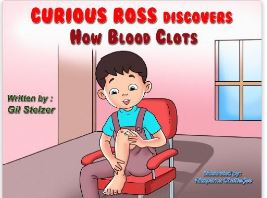If you want to explain blood clots to your kids or grandkids, we’ve found two helpful children’s books.
 Curious Ross discovers How Blood Clots
Curious Ross discovers How Blood Clots
by Gill Stelzer – a research scientist with a PhD in Molecular and Cellular Biology as well as a BSc in Computer Science
This is part of a series he’s written called ‘Educational science while you play’
About the book
- picture book
- suitable for 4-8 year olds
- 18 pages
- kindle version costs 80 US cents. Yes really! An absolute bargain
Content
A short and sweet story of a father and son in the kitchen. Dad cuts his finger and the son has a scab on his knee, both of which are used to explain clotting.
How it describes blood
“Inside our blood there are many cells, which are like balloons in many shapes. Some are colored red, others white and some are clear like glass.”
How it describes clotting
“[Cells] can create a type of bandage from inside our body… When we get cut [platelets] break near the wound, and their insides get released….a net is formed very quickly. It looks a bit like a spider’s web….The other cells inside our body get caught in the net.”
Paul’s take
“As a very simplified overview, this works.”
Using this to explain why you’re on anticoagulants
“Anticoagulant medicine makes it harder for my body to make a spider’s web. I take this medicine because my body made/might make a spider’s web in the wrong place, so that I was/could be sick.” Describe DVT, PE or stroke as appropriate in language children can understand.
Favourite parts
I like the way the little boy describes the blood cells getting caught in the fibrin web as being like his father’s cooking, “When the beans got caught in the sieve when you washed them with water.”
I read the book to our son Noah who has Down syndrome. He loved the story and was most impressed with the blood cells that “look like glass” (platelets, I presume).
 The Book of Blood: From Legends and Leeches to Vampires and Veins
The Book of Blood: From Legends and Leeches to Vampires and Veins
by HP Newquist author of more than a dozen books covering topics ranging from entertainment and technology to popular culture and finance.
About the book
- chapter book
- suitable for 8-12 year olds
- 160 pages
- kindle version costs US$7.87
Content
A non-fiction book with an immense variety of content, including medical history, mythology, religion, and animal biology as well as straightforward information about blood. Be sure you’re going to see posts based on some of the contents over the next few months!
How it describes blood
“Blood contains many components….Think of these components as being similar to the ingredients in a chocolate milkshake….there is the milk, sugar and flavoring…Like a chocolate milk shake, a lot of things go into making your blood. This starts with plasma ….think of plasma as the river in which all the other blood parts float.”
How it describes clotting
“Once collagen comes into contact with the blood stream, the platelets start bunching up together..At the same time the torn blood vessels squeeze tight…..little bits of fibrinogen mix with the platelets and form little threads of fibrin …creates a net that holds the mass together.”
Paul’s take
“Who couldn’t like the description of blood as a chocolate milkshake? The good thing about this clotting description is that it includes all the stages – primary haemostasis involving vessel spasm and platelet activation and secondary haemostasis making the clotting network.”
Using this to explain why you’re on anticoagulants
This book includes a fair amount about the vessels of the body, so you could talk about a DVT, in leg vessels, a PE in pulmonary vessels or stroke in the brain – the book actually has a description of the circle of Willis, a key part of the brain’s blood supply. If someone with atrial fibrillation, had a clot break away from the left atria, the clot would pass through the circle of Willis before settling in (most commonly) the middle cerebral artery.
You could explain that anticoagulants prevent the conversion of fibrinogen to fibrin, so make it harder for your body to form a clot.
Favourite parts
This is a wonderful book to dip into, with lots of information and some thought provoking items, like how blood is used as a symbol of fear, power and life in the Bible. I enjoyed learning that George Washington died after blood-letting and that the Lancet medical journal was so named because of the medical importance of blood-letting (using a lancet).
This is an easy read, but that doesn’t mean it’s just suitable for children.

Leave a Reply